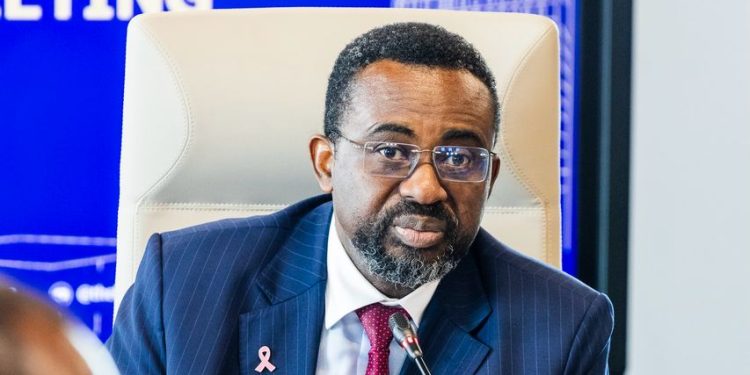The Bank of Ghana (BoG) has announced plans to issue new exposure drafts covering Liquidity Risk Management, Interest Rate Risk in the Banking Book, Stress Testing, and Recovery Planning, as part of a comprehensive effort to align Ghana’s banking regulation and supervision with international best practices.
Governor of the central bank, Dr. Johnson Asiama, disclosed this at a high-level meeting with Chief Executives of commercial banks in Accra, where he also urged financial institutions to further reduce lending rates to support private sector growth and job creation.
He emphasised that the recent cuts in the Monetary Policy Rate (MPR) should be reflected in commercial lending rates to help boost access to credit, particularly for small and medium-scale enterprises (SMEs) — the backbone of Ghana’s economy.
“While the central bank has reduced its policy rate by over six percentage points in recent months, lending rates in the banking sector have remained relatively high,” Dr Asiama said.
“The Monetary Policy Committee voted to cut the rate by 350 basis points to support disinflation. This is the third rate cut in 2025, reflecting our confidence that inflation will remain within the medium-term target band.”
Lending rate cuts to stimulate growth
The Governor underscored that lowering borrowing costs would be essential to sustaining Ghana’s post-recovery growth momentum, improving private sector confidence, and deepening financial inclusion.
“The central bank stands ready to act decisively if risks emerge, including possible tariff adjustments, but we expect further improvement as banks realign their pricing models,” he added.
Dr. Asiama assured industry leaders of BoG’s commitment to maintaining macroeconomic stability and strengthening collaboration with commercial banks to enhance the efficiency of credit delivery and the resilience of the banking sector.
Strengthening prudential oversight
In addition to the forthcoming exposure drafts, the BoG has rolled out several key directives in 2025 to fortify prudential regulation, including the Bancassurance Directive, the Large Exposures Directive, and the Guidelines on Credit Concentration Risk Management.
The new risk management frameworks, Dr Asiama said, form part of a broader strategy to ensure that Ghana’s financial system remains robust, transparent, and well-positioned to handle external shocks.
Latest industry data show encouraging trends: the Capital Adequacy Ratio (CAR) has risen to 17.7%, while Non-Performing Loans (NPLs) have declined to 20.8 per cent—still elevated, but indicative of sustained improvement.
“The task of consolidating stability is a shared one,” he cautioned. “Sustaining a stable exchange rate, deepening credit to productive sectors, and expanding exports require close collaboration between the Bank of Ghana and the banking industry.”
Dr. Asiama also encouraged banks to design export-oriented financial products, support SMEs and agribusinesses, and enhance foreign exchange sourcing through formal channels.
He urged compliance with local regulations, including the use of domestic insurance companies for import coverage, to curb FX leakages and build local liquidity.
He further encouraged banks to list publicly on the Ghana Stock Exchange to strengthen capital, improve transparency, and enhance long-term growth prospects.
Inflation returns to single digits
The meeting came just two weeks after the Monetary Policy Committee’s (MPC) 126th session, which reviewed economic developments and projected continued progress in inflation control and growth performance.
According to Dr. Asiama, Ghana’s macroeconomic indicators are showing their strongest performance in years.
Inflation fell to 9.4% in September 2025, marking the first return to single digits in four years and the ninth consecutive monthly decline.
Food inflation dropped sharply to 11%, while non-food inflation eased to 8.2%, reflecting the combined effects of prudent monetary management, fiscal discipline, and stable liquidity conditions.
“The return to single-digit inflation marks a new chapter in Ghana’s economic recovery,” Dr. Asiama said.
“But it is not the end of the story. Our collective responsibility now is to sustain discipline, strengthen the financial system, and ensure that stability translates into jobs, affordable credit, and real growth.”
Strong growth and external stability
Ghana’s growth trajectory has also been positive. Data from the Ghana Statistical Service show that the economy expanded by 6.3% in the second quarter of 2025, with non-oil GDP growing by 7.8%, driven by services and agriculture.
The Composite Index of Economic Activity (CIEA) rose by 6.1% in July, signalling continued expansion in domestic demand and production.
Externally, Ghana recorded a trade surplus of $6.2 billion in the first eight months of 2025, while international reserves climbed to $10.7 billion, equivalent to 4.5 months of import cover.
The cedi has appreciated by 21% year-to-date, ranking among the best-performing currencies globally.
“This performance underscores the growing credibility of our policy framework and the renewed confidence of both domestic and international markets,” Dr. Asiama noted.
Transmission of policy easing
The Governor revealed that the recent monetary policy easing is already filtering through to the financial system. Treasury bill rates have declined from 13.4% in July to 10.3% in August, while average lending rates have dropped from 26.6% to 24.2%.
“We expect further improvement as banks adjust their models to reflect the lower policy rate,” he said.
Collaboration for sustainable recovery
Dr. Asiama reiterated that the BoG will continue to work closely with the banking community to strengthen financial intermediation, promote stability, and ensure that the benefits of economic recovery reach households and businesses.
“The Bank of Ghana will continue to engage through open dialogue, consistent regulation, and shared purpose,” he assured. “Together, we can transform stability into inclusive and sustained prosperity.”













